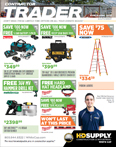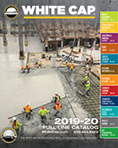Is Your Job A Pain In The Neck?
Work Smart to Avoid Injuries
Everyone knows about the big ticket injuries on construction sites: falls, electrocution, struck-by accidents, and caught in betweens (also known as the “Fatal Four“). These cause serious injury and often death. OSHA estimates that 800 people are killed and over 137,000 construction workers are seriously injured on the job every year.
However, you don’t have to fall off a ladder to be seriously hurt and out of work for a long period of time. Many work site injuries occur from the strains, sprains, repetitive motion, or awkward positioning that happen in all types of construction work. Learning how to avoid foot, knee, back and neck injuries by focusing on safety and by implementing just a little bit of prevention will lessen the extent and harm to workers.
PROTECT YOUR FOUNDATION
If you’ve ever dropped a hammer or any other tool on your foot, you know how that feels. One good way to protect feet is by stepping into quality work boots. ASTM F2413-18 is the Standard Specification for Performance Requirements for Protective Toe Cap Footwear. It sets the standard for “footwear designed to be worn to provide protection against a variety of workplace hazards that can potentially result in injury.” OSHA also requires that employers ensure their workers use protective shoes at work sites.

Safety work boots should include steel-toes (or aluminum-toes or composite-toes) to protect against objects that might fall on or pierce the toe box. Slip-resistant soles minimize injury due to slipping on spilled chemicals, water, or any sort of onsite liquids. Boots should also be water proof or water tight. Proper fitting work boots also protect ankles from rolling. Most boots are made from full-grain leather, which is also still the choice of many workers, although there are some newer synthetic materials out there.
It’s important that the work boot isn’t too heavy. A heavy boot can cause leg and feet fatigue to the wearer. And for someone walking well over the prescribed 10,000 daily steps, a heavy boot will catch up to them. They aren’t necessarily more durable either; today’s lightweight boots provide all the protection and durability needed without the extra weight.
Work boots are more durable, comfortable and protective than ever. Insist that workers take the time to find work boots that are the perfect mix of fit and protection. Their feet will thank them.
KNOW YOUR KNEES
Most occupations require functioning knees to some extent, but this is especially true for construction workers. From electricians to welders to tile setters to concrete and flooring workers, construction trades bear the brunt of knee injury and knee pain. Protecting knees is paramount, so simple actions like proper bending when lifting and stretching really help. OSHA recommends taking micro breaks of 10-20 seconds to extend the leg and allow blood flow through the leg. When it’s time to get back to work, Personal Protective Equipment (PPE) such as knee pads also help.

Knee pads work to absorb impact and cushion and distribute pressure across the broader portion of the knee. When working on hard surfaces especially, the use of knee pads can alleviate pressure and allow for longer periods of work time. Using proper protection for your bones and joints can extend your careers. We all know guys in the trades, some in their 40s, who don’t want to retire but their knees and/or backs just can’t take any more abuse.
Knee pads are usually adjustable and many have anti-slip covering on the caps. Some pads flex and conform to the knee, while others are stiff. There is basically a knee pad for every utility. Finding the right knee pad for the job and the right fit for the worker is key.
In cases where wearing knee pads isn’t feasible, the use of kneeling pads could help. These are thick, portable pads that can be kneeled upon for a short time.
Maybe you don’t consider knee pads safety equipment but anyone who has had a knee injury will recognize that protecting knees is a critical part of getting the job done.
SUPPORT YOUR BACK & NECK
No matter what your trade is, you are putting your back into it. According to the Center for Construction Research and Training, construction workers report back pain in higher numbers than all other industries combined. The back is the hardest working part of the body and it’s so easy to suffer a back injury that can put you off the job for long periods of time.
According to OSHA, the five most common risk factors for developing back pain are:
- Lifting
- Pushing, pulling and tugging
- Twisting, reaching, sideways bending, unequal lifting
- Working in a single position
- Whole body vibration
To keep backs in shape and protected while at work, there are a few tricks:
- When lifting heavy objects, get some help from carts, forklifts, dollies, another worker, etc.
- Move with care by bending your knees more, turning your whole body toward what you are lifting and not twisting. Hold the object close to the body. Lift and lower items slowly, in a steady fashion.
- Wear a back brace if you can still move freely while wearing it.
Since our necks are connected to our backs, we’ll go there next. Neck and shoulder strain is a byproduct of every construction job. From roofers at the top, to concrete finishers on the ground, to everyone in between, construction workers commonly overexert their neck and shoulders. One of the easiest ways to strain the neck is by working overhead. It causes your neck to be out of its normal position while using tools and exerting force. This puts excess stress on shoulders and necks.
To minimize neck strain, consider the following:
- Using tools with extension handles
- Working on a lift that can raise up to the work, rather than extending your arms overhead
- Setting time limits on overhead work and taking regular breaks

Basic Safety Tips to Avoid Injury
Keeping all parts of the body safe and protected is critical for getting the job done efficiently and without injury. All construction workers doing all sorts of jobs can benefit from following a few simple guidelines:
- Put on the PPE – Hard hats, gloves, safety glasses, steel or composite toe boots all need to be part of the daily uniform.
- Limber Up – Don’t be shy about leading an on-the-job stretch in the morning. Better to feel a little awkward than throw your back out.
- Take a Seat – Whenever possible, opt for sitting rather than kneeling or squatting.
- Don’t Overextend – For trades that require overhead work, use a lift to raise up to the work, rather than extending arms overhead for long periods of time.
- Bend at the Knee – We all know what to do here, especially when lifting.
- Clean Up Aisle 1 – Be sure to soak up spills and keep ground free of wires, cables or debris.
- Shake up your Routine – Reposition your body while working and take frequent breaks to stretch.
While you may not be able to immediately see how taking the extra step to strap on some knee pads or lift a heavy piece of machinery with extra care benefits the bottom line, you will appreciate it when you or your workforce is healthy and injury free. Making even small changes can help prevent or avoid injury.
![]()
Follow these links for more info on ergonomics in construction:
https://outlook.wustl.edu/building-better-health/
https://www.cpwr.com/research/research-practice-library/construction-ergonomic-research-solutions




